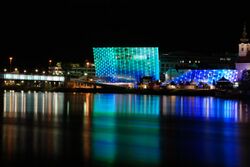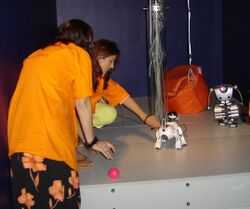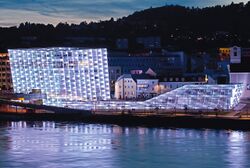Organization:Ars Electronica Center
| It has been suggested that this page be merged into Ars Electronica. (Discuss) Proposed since March 2020. |
 The Ars Electronica Center at night | |
| Location | Linz, Austria |
|---|---|
| Coordinates | Template:Coord/display/title, inline |
| Type | Center for electronic art |
| Key holdings | Ars Electronica FutureLab |
| Architect | Treusch architecture ZT GmbH |
| Owner | Ars Electronica |
| Website | Official AEC Site |





The Ars Electronica Center (AEC) is a center for electronic arts run by Ars Electronica situated in Linz, Austria, at the northern side of the Danube opposite the city hall of Linz. It has been built on the right side of the Nibelungenbrücke.
Museum 1996–2014
The building is also known as the "Museum of the Future"[by whom?]. The most modern techniques from the technology sector are presented to the museum's visitors.
Museum exhibits
The top of the AEC is called the "Sky Media Loft", which is mainly used as a coffee house or bar of the museum. It can also be rented out for meetings or events. The bar has occasionally been used as the studio for the Newscast of the local TV branch of the Austrian national TV organization ORF. The speciality of the "Sky Media Loft" is the marvellous view over the Nibelungenbrücke and the main place of Linz at the other side of the Danube which functions as background of the Newscasts.
The second floor is also the floor where people can interact with exhibits. There are Musicbottles containing different types of music or Pingpongplus which is a table tennis game on a desk with virtual water on its surface.
The first floor has displays about the world that had been hidden from our eyes. In the "Hidden Worlds" various machines are translating voice and words into virtual symbols or colours and everyday life articles can be moved on a screen if they are touched.
The little room between the first and the ground floor one of the main attractions is offered. The flight simulator "Humphrey" uses virtual reality goggles to give users a simulated view of the flight and the person taking the trip is connected to the computer by cables fixed all over the body. It is possible to fly everywhere and to see the movements of the hands, feet and the landscape if the visitor raises the head or looks down.
The entrance or the so-called "Login Gateway" of the museum is on the ground floor and leads the newcomer directly to the Telegarden where a robot is looking after a flower patch. Every ticket is provided with a bar code that gives information about the time the visitor entered the museum. After the visit the ticket can be put into a computer near the Exit and it gives statistic information about the things that happened in the world during the span of the stay in the AEC. The List that is printed out gives information about how many people died or were born during that time or how many accidents have been caused by drunken drivers.
The last floor is called "Virtual Reality" and it can be found in the basement of the building. The CAVE is another attraction of the museum. The cube with 3 meters side length is used as a screen to project the virtual world. There are always groups of about 10 that dive into a world were no physically laws do not have any meaning. Additionally, the 3D spectacles give the impression of a bodyful environment.
Museum 2009–present
The new Ars Electronica Center, which was designed by Treusch architecture ZT GmbH, opened its doors on 2 January 2009 after roughly two years of construction work and an approximate cost of 30 million Euros. It now has 3000 square meters for exhibitions, 100m2 for research and development, 400m2 for workshops and conferences, 650m2 for catering and another 1000m2 square meters of public space for various types of events, e.g. Red Bull Upside Down on 12 February 2010.[1]

The new AEC consists of the original building, a new "twin-tower", the main exhibition hall called "Main Gallery" and the new space for the Ars Electronica Futurelab. The whole building is covered with a 5000 square meter glass skin that consists of 1100 glass panels. Each panel is equipped with an LED Bar that allows it to change its color. Therefore, the whole building acts as a giant display. Artists can create their own visualisations which will be shown on various occasions, especially during the Ars Electronica Festival.
The restaurant is located on the third floor of the new building and is called CUBUS, referring to the building's cubic shape.
Museum exhibits
With the new building came a new thematic orientation inside of Ars Electronica. Life sciences, global developments (e.g. climate change, population growth, environmental pollution) and the exploration of the universe are just a view of various new topics. The museum can be separated into the following areas:
Main Gallery
Main Gallery with approximately 1000 square meters houses the main exhibition called "New Views of Humankind", which focuses on topics like biotechnology, robotics, rapid prototyping and the human body. It is separated into the following four so-called "Labs":
- Brain-Lab: this area focuses on the human brain, perception and advances in medicine.
- Bio-Lab: in this lab, the focus lies on biotechnology and its applications.
- Fab-Lab: this lab. deals with new possibilities offered by 3D printers and rapid prototyping.
- Robo-Lab: this lab. deals with robotica as well as different prothetic systems.
Main Gallery contains a special area for children which is not thematically connected to the main exhibition.
Geo City
Geo City focuses on global developments caused by humankind, like growth in population and the extraction of natural resources. Those global developments are connected with possible local reactions, which is visualized in an interactive City Information System called Sim-Linz.
Artists, Creators, Engineers
This is the area for temporary exhibitions consisting of the first and second floor of the original building and focuses on the interdisciplinary aspects of Ars Electronica and its contributors. Detailed information about current and future exhibitions can be found at the official web site.
Deep Space
The Deep Space [3] is a multifunctional presentation room that offers a wide range of possibilities. It consists of two walls (front and floor) with dimensions of 16:9 meters which serve as screens for 8 Galaxy NH-12 projectors by Barco.[4] The range of projects ranges from high-resolution videos to scientific (3D) visualisations like a flight out from the solar system to the whole known universe and artistic projects. Dates of special events involving Deep Space presentations can be found at the official web site.
FutureLab
The same building holds the Ars Electronica FutureLab, a place for researching and trying out new cyberarts technologies. See also the Prix Ars Electronica, a yearly award ceremony given out by Ars Electronica at their cyberarts festival. Since 2004, one of the awards at the Prix Ars Electronica brings a young innovator or team of innovators to the FutureLab for a summer to develop a budding idea or technology in electronic media.
Bibliography
- Van Uffelen, Chris. Contemporary Museums - Architecture, History, Collections, Braun Publishing, 2010, ISBN 978-3-03768-067-4, pages 144-145.
References
- ↑ "Archived copy". Archived from the original on 2010-08-19. https://web.archive.org/web/20100819094135/http://www.aec.at/center_about_en.php. Retrieved 2010-07-26.
- ↑ "ESO Art & Science Residency Applications Open". http://www.eso.org/public/announcements/ann15081/. Retrieved 22 October 2015.
- ↑ "Archived copy". Archived from the original on 2010-08-10. https://web.archive.org/web/20100810015835/http://www.aec.at/center_exhibitions_ds_en.php?id=96. Retrieved 2010-08-16.
- ↑ "Visualization at the heart of futuristic immersion". Archived from the original on 2010-02-25. https://web.archive.org/web/20100225143425/http://www.barco.com/en/reference/3887.
External links
